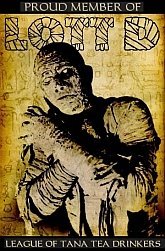
Zombos Says: Good
When Price's performances failed as touching works of naturalistic brilliance, they usually succeeded as thrilling romps of stylish theatricality. As a result, almost any Price performance is worth watching--for one reason or another. (Mark Clark in Smirk, Sneer and Scream: Great Acting in Horror Cinema)
Crypt of Horror's DVD offering of 1954's Columbia Pictures' 3-D The Mad Magician is quite the trick indeed. It fooled me into thinking I was going to have a wonderful evening of murder done with panache, prefixed by that delightful glare of homicidal haughtiness, so patently and masterfully executed by Vincent Price in many of his films. Instead, the DVD's murderously shoddy performance got in the way; enough to make me as mad as Gallico the Great.
 The DVD case cover blurb "Homicidal Maniac weilds Buzz Saw horror against beautiful young women!" is quite foreboding to begin with. It's not bad enough horror fans must constantly battle a public and familial image of being either illiterate ignoramuses or pimply, basement-dwelling, punk-rocking misfits lusting after beautiful young women (Goth babes especially), but misspelling a simple word like "wield" instead of the more complex word like "homicidal" doesn't help our case at all now does it? And which homicidal maniac wielding a buzz saw against beautiful young women are we referring to? There's certainly no one in this 1954 period movie that fits that description.
The DVD case cover blurb "Homicidal Maniac weilds Buzz Saw horror against beautiful young women!" is quite foreboding to begin with. It's not bad enough horror fans must constantly battle a public and familial image of being either illiterate ignoramuses or pimply, basement-dwelling, punk-rocking misfits lusting after beautiful young women (Goth babes especially), but misspelling a simple word like "wield" instead of the more complex word like "homicidal" doesn't help our case at all now does it? And which homicidal maniac wielding a buzz saw against beautiful young women are we referring to? There's certainly no one in this 1954 period movie that fits that description.
Following on the heels of Warner Brothers' successful 3-D House of Wax in 1953, Price once again dons a vengeful smock, this time playing an inventor of magic tricks and stage illusions who dreams of performing his creations in front of the footlights. On the night of his successful debut performance, performing as Gallico the Great, he's stopped by his unscrupulous employer who holds an ironclad contract not even Lucifer himself could get out of.
Just as Gallico was stopped from performing his magic, I was stopped, repeatedly, by Crypt of Horror's DVD-R cheapie disc duplication process as it brazenly jumped scenes and unexpectedly paused, taunting me to the brink of homicidal ideation. I was ready to lose my head, but Gallico the Great beat me to it.
 Turning slightly daffy, he gives his soon-to-be-former gloating employer, Ormond, a really close look at his buzz saw illusion in action. That horrific scene, with Price's demonic glaring and vibrant voice spewing invectives, and the whirring blade swinging closer to finally slice off Ormond's head--conveniently done out of sight to avoid those messy 1954 censorship issues--is still frightfully effective. But there's no blood! Not one drip nor spray nor streak. If remade today there would be buckets of blood flying in all directions, along with bits and pieces of tracheal innards. Yet due to Price's theatrics, and the tightly framed action, it's still a highlight in an otherwise disappointing directorial effort by The Lodger director, John Brahm.
Turning slightly daffy, he gives his soon-to-be-former gloating employer, Ormond, a really close look at his buzz saw illusion in action. That horrific scene, with Price's demonic glaring and vibrant voice spewing invectives, and the whirring blade swinging closer to finally slice off Ormond's head--conveniently done out of sight to avoid those messy 1954 censorship issues--is still frightfully effective. But there's no blood! Not one drip nor spray nor streak. If remade today there would be buckets of blood flying in all directions, along with bits and pieces of tracheal innards. Yet due to Price's theatrics, and the tightly framed action, it's still a highlight in an otherwise disappointing directorial effort by The Lodger director, John Brahm.
Not being a mentalist, Gallico the Great Klutz promptly loses his severed head when he places it in a leather bag that matches the one his comely stage assistant (Mary Murphy) is carrying. Off she goes to dinner--I wonder what she was carrying before she switched bags because she doesn't seem to mind the extra weight--and Gallico frantically runs after her to get it back. Not being an assistant to a mentalist either, when he catches up with her he finds she's gone and forgotten the bloody thing in a hansom cab. But not to worry: the cabby played good samaritan and turned it in to the local constabulary. This ghoulishly humorous interlude, made memorable by Price's naturally subtle comedic instincts, ends well for him, though his odd behavior running down the bag piques the interest of his assistant's detective boyfriend (Patrick O'Neal).
Inexplicably, Gallico pretends to be Ormond, and donning a mask and changing his voice, he rents a room from the local nosy mystery writer. No sooner can you say "sinister Sam Spade snookers six slithering snakes," Ormond's wife and Gallico's ex-wife are invited in for tea by the meddling mystery writer who recognizes her new boarder from a newspaper photo. Ormond's wife (Eva Gabor) surprises Gallico thinking he's Ormond. Not having the buzz saw handy, he has to rely on good old-fashioned strangulation to let her know how much he doesn't like her anymore.
So far, she's the only beautiful young woman he kills, and he didn't even use a buzz saw. His next victim is definitely not a beautiful young woman: he gets even with the conniving Rinaldi (Kronos' John Emery), a rival magician. The climactic scene with the cremation illusion jumped past the point of my patience after repeatedly going through Crypt's Disc of Horror torture test, but it's a sizzling climax when seen in its entirety.
The illusions in the film, including the buzz saw, the cremation, and the water fountains, are based on noted stage illusions made famous by such magicians as Horace Goldin and Harry Blackstone Sr.--though Ricciardi threw in the innards and blood for the buzz saw, and the Great Rameses performed a version of the cremation illusion. One illusion in the film done with mirrors reveals the secret. Perhaps done in 3-D it wasn't noticeable.
The bug-eyed music is distinctly 1950s terror in flavor, and adds to the overall mood of the film, especially in tandem with Price's sinister stare. Introducing the movie is Lon Midnight and his equally odd friends. Lon's cheesy horror hosting shenanigans, which didn't suffer from the dubious duping process, were in keeping with the movie's theme and are fun to watch.



Comments